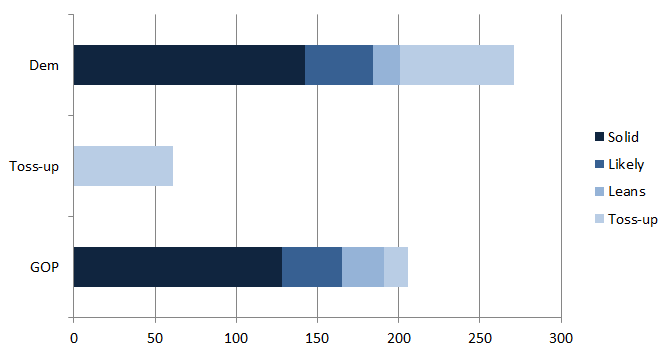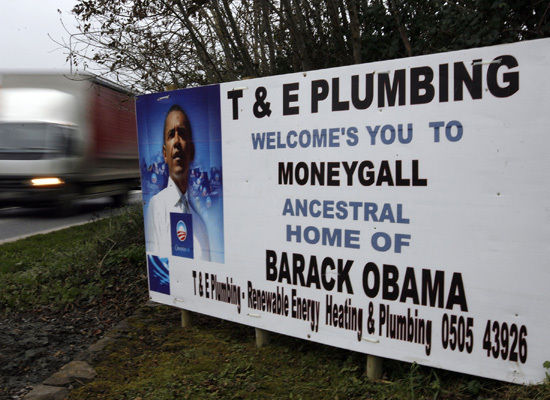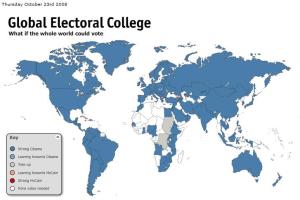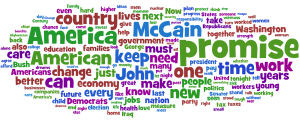An Election 2012 cheat-sheet – where to watch out for
This roots of this blog actually lie in some miscellaneous thoughts on the U.S. Presidential election of 2008. Four years on, and another election less than a week away, I thought it would be useful – for me if for no-one else – to have a quick look through what’s “in play” this time around.
The U.S. Presidential election is not so much an exercise in democracy – on a number of occasions, the victor has not been the person with most votes – as it is a race to 270. There are, as many know, 538 Electoral College votes and these are (almost always) given at state-level in a winner takes all contest. He who gets 270 or more (Obama won 365 in 2008) is President.
Given it is not so much one vote as it is the aggregation of a number of winner-takes-all contests, this actually makes it a good bit easier to talk about probabilities of winning. (Certain pundits have actually embarrassed themselves in this regard in the last couple of days, by showing a total lack of understanding of either the college system or more likely basic statistics.)
The bankers
Like every good democracy, a candidate needs the support of bankers to get up and running. Analysts typically write off 26 of the 51 States (yes, I know D.C. isn’t really a state) as bankers one way or another, with sixteen (Alabama, Alaska, Arkansas, Idaho, Kansas, Kentucky, Louisiana, Mississippi, Nebraska, North Dakota, Oklahoma, Tennessee, Texas, Utah, West Virginia and Wyoming) staunch Republican and ten staunch Democrat.
Advantage Romney? The problem for Republicans is that just one of these sixteen – Texas, with 38 – is a big hitter in college votes. Tennessee and Alabama together bring another 20, while the remaining lucky thirteen account for seventy in total.
The ten Democrat states are split evenly between big and small. California, with 55 votes, is huge, while Illinois (20) and New York (29) also matter a lot. Maryland (11) and Massachusetts (10) are also double-digits, while the remainder (D.C., Delaware, Hawaii, Rhode Island, Vermont) account for just 3 or 4 each. The end result is that, on the road to 270, it is advantage Democrats after accounting for the bankers, 142-128.
The likely lads
Those thinking to themselves that a system where voters in just half the states have any chance of influencing the outcome does not sound like much of a democracy, turn away now! A further 14 States are considered (by Real Clear Politics among others) to be likely or leaning one way or the other. Likely means a double-digit lead in the polls for one candidate, while leaning means a lead of 5-10 percentage points (statistically significant, one might say).
Good news for Republicans is that three states – worth 37 votes in total, Georgia, Indiana and Missouri – are likely Republican states. Indiana (with its 11 college votes) is the only state choosing Obama in 2008 that appears to have reconsidered – Romney is ahead by 12% in the polls. Missouri is a funny one as Romney’s double-digit lead in the polls is at odds with much tighter margins in the last three elections. In addition to those three states, there are four GOP-leaning states also, most significantly Arizona (11 votes) but also South Carolina (9), South Dakota (3) and Montana (3).
There also seven states likely or leaning Democrat. Five states accounting for 42 votes – Connecticut, Maine, New Jersey, New Mexico and Washington – are “likelies”, while Minnesota and Oregon account for a further 17 votes leaning Democrat. All of these – except New Mexico in 2004 – have been blue states since 2000, so it is relatively safe to bet that they will stay that way.
After the bankers and the likely-lads are all totted up, the Democrats can effectively count on getting 201 electoral college votes, while the Republicans are looking at 191, assuming Missouri polls are accurate.
The toss-ups
So the kernel of the U.S. election is that its outcome will almost certainly come down to just 11 states, Colorado, Florida, Iowa, Michigan, Nevada, New Hampshire, North Carolina, Ohio, Pennsylvania, Virginia and Wisconsin.
Of these 11 states, five currently have Obama ahead by more than 2 percentage points (skirting the bounds of statistical significance). What is crucial for the outcome of the election is that these five account for a meaty 70 college votes: Michigan (16 votes), Nevada (6), Ohio (18), Pennsylvania (20) and Wisconsin (10). If these five states were to hold for Obama, that would be that – 271 votes with six states still to account for.

The only toss-up currently going Romney’s way is North Carolina (15). From a GOP viewpoint, it would want to – if Romney can’t take a state that only gave Obama a 0.3% margin in 2008, and was double-digit Bush territory in 2000 and 2004, then he’s in trouble. These forty-six states are shown in the graph above, and point to an Obama win.
A Romney win?
There are five states that are too close to call, most importantly Florida (29), but also Virginia (13), Colorado (9), Iowa (6) and New Hampshire (4). Romney is ahead in both Florida and Virginia at the moment (just).
Suppose he won those two. Adding them and North Carolina to the GOP total so far gives 248 votes. Pennsylvania looks beyond Romney’s reach so hence the focus on Ohio, where Obama is ahead by 2.3% in the polls. An Ohio win added on would leave Romney on 264 votes, just shy of the 270 needed. Colorado is a state that twice voted for Bush and has Obama only marginally ahead currently. Its nine votes would be enough for a Romney victory.
The cheat-sheet redux
So, what should you watch out for in the wee hours of next Wednesday morning?
Nevada and Ohio are Obama’s most fragile possessions of the 271 votes outlined above. Without their 24 votes, Obama would need Florida – or Virginia plus two of New Hampshire, Colorado and Iowa – to win. If he keeps those two, though, he is on course for re-election, barring surprises.
Potential surprises include an Obama win in North Carolina, if news of which broke early in the evening, you could retire relatively safe in the knowledge that Obama would be re-elected, or alternatively Obama struggling in any of Michigan, Pennsylvania or Washington.
Romney’s route to victory requires winning not just Florida and Virginia, where he is currently ahead, but also Ohio and Colorado.
If Arizona or Minnesota – or indeed anywhere else – is being discussed by pundits on the night as a possible upset, then it’s probably best to get the popcorn out, it’ll be a long night!







